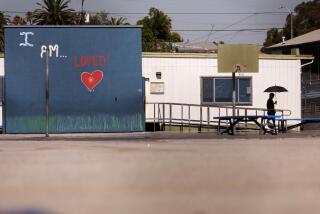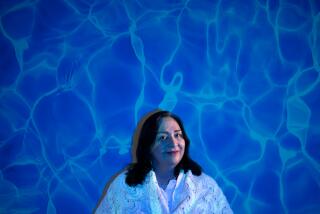Happy Birthday, AC: 100 Years of Playing It Cool
- Share via
The man you should be thanking today, and tomorrow and pretty much every day from now until sometime in October, is Willis Carrier. He’s the reason beach traffic isn’t worse than it is and the urban death toll rises less dramatically during summer months. He’s why computers can exist, why the Sistine Chapel should last a few more centuries, why there are bananas for breakfast and chocolate bars after lunch, why there’s such a thing as a summer blockbuster.
He made summer school possible and the summer workweek longer, but we won’t hold that against him because 100 years ago today, Carrier invented air-conditioning, and if that seems like a small thing, just imagine life without it.
“He’s right up there with Salk and Edison and Henry Ford,” says Jon Shaw, senior manager of communications for the Carrier company, named for its founder and still the country’s largest air-conditioning manufacturer. “But most people don’t know who he is or what he’s done. Everyone just takes air-conditioning for granted.”
Certainly by mid-July, most Americans take air-conditioning for granted. As the temperature rises in June, everyone notices the AC. It’s hard not to. Folks entering malls and corporate towers and movie theaters are met with a sudden glacial back-draft. Women wander through the office place in search of sweaters, blowing on their hands. “It’s not that hot,” they mutter, scurrying outside for a few minutes just to warm up.
But by mid-July, in almost every region of the country, it is indeed that hot, and the heat’s settling back on its haunches, planning to stay awhile. During these dog days, air-conditioning becomes just another utility, like water and electricity--necessary and constant, a forgotten blessing (until the power goes).
So it seems fitting that the 100th anniversary of the invention of air-conditioning is July 17, a day in which temperatures in Southern California are expected to reach the upper 80s and as high as the upper 90s elsewhere in the nation. To mark this birthday, no doubt, most of the more than 80% of American homes and 90% of businesses that have some form of air-conditioning will set the dials somewhere between high and arctic blast. And if people complain that it’s too cold inside, well, they can go sit on the front stoop like folks did in the old days.
“I know work got done back then,” says Shaw, from Carrier’s Syracuse offices, “but it’s 90 degrees out there, and right now I’d rather be sitting here comfortable than literally sweating over my desk.”
Air-conditioning was, in fact, invented to solve the detrimental effects of heat in the workplace, but not for the benefit of humans. In 1902, a Brooklyn printing company was having trouble keeping paper stable during the summer--the heat and humidity changed its dimensions, so the images printed fuzzy and out of whack. Carrier, then a 25-year-old mechanical engineer, designed a system to control the temperature and humidity around the printing press.
Four years later, engineers used Carrier’s system to “condition” the air at a cotton mill in North Carolina. Although the name “air-conditioning” stuck, it wasn’t until 1914 that anyone tried to use the technique to make people, rather than paper or fiber, more comfortable; Minneapolis millionaire Charles Gates commissioned the first home system.
In 1922, Carrier developed the centrifugal refrigeration system, and two years later, J.L. Hudson, a Detroit department store, installed it in the bargain basement so sales could continue through the summer. Then, in 1925, Grauman’s Chinese Theatre in L.A. and the Rivoli Theater in New York decided to cool down that flickering dark, and the rest is history.
History in the literal sense. Last month, the Smithsonian Press published the first cultural history of air-conditioning: “Cool Comfort: America’s Romance With Air-Conditioning,” by Marsha Ackermann, a lecturer in history at East Michigan University. Ackerman, who grew up in Carrier’s hometown of Buffalo, is interested in things that Americans take for granted. “I wanted to show that air-conditioning wasn’t this miraculous technology that was invented and then everyone had it.”
In the beginning, she discovered, AC was a hard sell. It was expensive and it was newfangled. Business owners would invest in equipment if it improved the productivity of their machinery; they were not at all interested in the comfort of their workers. Air-conditioning was often used to increase the heat. The term, and the technology, Ackermann explains, was not originally synonymous with cool; it was simply a way of controlling temperature and humidity.
It wasn’t until after World War I that anyone in the burgeoning industry thought to expand its horizons by defining coolness not only as the epitome of comfort but as a sign of intellectual and physical superiority. For hundreds of years, Ackermann writes, the Nordic races had considered the endurance of colder climes to be an achievement, indicative of their racial prowess. People from warmer climes were considered slower-witted, their brains having gone languid in the perpetual sunshine.
In early campaigns for air-conditioning, these beliefs were exploited. If employers were not impressed by the thought of a more comfortable workforce, they were a bit more taken with the image of a smarter, more productive one.
But movie palaces increased the popularity of air-conditioning more than any ad campaign. Even in these days of almost universal air-conditioning, people find sanctuary in the theater during the summer months. In the 1920s, there was no other place like it on Earth. “Relax in Cooool Comfort,” the signs would tempt; the Rivoli guaranteed “always 69 degrees.”
As air-conditioning became more widespread--by the 1950s, it was fairly common in homes--it became a favorite target of social critics and bohemians.
“Henry Miller saw it as a symbol of the bland conformity of American life,” says Ackermann. “He wrote a book called ‘Air Conditioned Nightmare.’ Other people have connected it to the isolation of the new suburbia--people stayed cool in their houses rather than gathering on the front porch.”
Ackermann doesn’t think air-conditioning should take the rap for suburban malaise--television, she says, probably has more to do with it--but she says universal availability of air-conditioning has changed Americans’ relationship to heat, both literally and as metaphor. As she points out in her book, heat is a time-honored literary device, a catalyst and symbol of simmering hatred, passion, oppression, all manner of things that often led to acts of violence--or great sex. From “Cat on a Hot Tin Roof” to “In the Heat of the Night” the steamy summer heat is as much a character as any of the people.
“[Jay] Gatsby is murdered on the hottest day of the year,” Ackermann says. “[The movie] ‘Body Heat’ would be nothing if not for the sweltering weather. Gore Vidal lamented the demise of pre-air-conditioned Washington, with its slow moving overhead fans. No doubt a certain atmosphere has been lost. But,” she adds, “if you need your characters to be hot, you can still take them outside.”
In exchange for the hypnotic image of those slow-moving fans, she says, we have gained virtually everything that has come to mean modern society. Without air-conditioning, there would be no high-rises, no glass towers, no windowless offices. “We’d have no computers,” she says, “because computers require a consistent temperature and level of humidity, which is also necessary for a lot of scientific research, particularly in the pharmaceutical industry.”
Our diet would be different without AC--tropical fruits, such as bananas, do better in air-conditioned, rather than refrigerated, conditions and all those chocolate bars stashed in desk drawers and vending machines would be gooey puddles in the summer months. Ancient paintings and works of art would deteriorate faster without climate control--the Sistine Chapel got a specially designed system just a few years ago.
But if early fears that air-conditioning shock--that initial skin-crawling moment after stepping into or out of a chilled building--would lead to widespread disease have been proved mistaken, the drain on public utilities has not. Where once power companies welcomed air-conditioning as ballast to the hump that occurred during winter months, now they view July with trepidation. An attempt in the 1970s by President Jimmy Carter to force Americans to moderate their energy use by setting thermostats no lower than 78 degrees was a complete failure.
More recently, air-conditioning exacerbated the crisis that led to the brownouts and blackouts in Southern California last year, and now many power companies are looking at ways to regulate air-conditioners, to lower them even by a few degrees during peak usage periods. At Carrier, the latest technology would allow homeowners and utilities to either preset temperatures throughout the day or change them through remote control. So far, Shaw says, the company is working with San Diego Gas & Electric, Con Edison in New York, Long Island Power and a few others.
“It allows homeowners to turn off the air when they’re not there and then turn it back on just before they come home,” he says. “Which alone can save you a few hundred bucks a year. But utilities can also turn a whole grid down a degree or two during peak times, which people probably wouldn’t even notice.”
All of which should add yet another facet to the remote-control war between the sexes. According to Shaw, the only complaints people have with air-conditioning is that it’s either too cold or not cold enough. And although there has been no formal study of the gender breakdown, after eight years in the biz, Shaw says invariably it’s women who are too cold and men who are too hot.
“Don’t ask me why,” he says, laughing. “I don’t even want to guess.”
Ackermann, who tends to be too cold, says even she’s grateful for the chill blast on days when the thermometer tops 90. But, she says, even then, air-conditioning is not right for every venue. “The Houston Astrodome was an achievement of air-conditioning technology,” she says, “but it was not a success. People want to experience the outdoors at a ballpark, including the sweaty people.”
More to Read
Inside the business of entertainment
The Wide Shot brings you news, analysis and insights on everything from streaming wars to production — and what it all means for the future.
You may occasionally receive promotional content from the Los Angeles Times.











